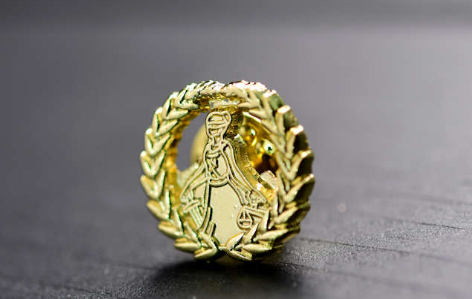Die-cast pins are custom lapel pins made using a casting process where molten metal is injected into a pre-made mold under high pressure. This method allows for the creation of pins with intricate details, complex contours, and varied textures that are more sophisticated than those produced by stamping or die-striking processes. Read our custom die-cast pins guide, we’ll break down the process, advantages, prices, and differences between 2D and 3D.

The Process Of Manufacturing Die Cast Pins
-Design and Mold Creation: A custom mold is created based on the specific design of the pin. This mold is carefully crafted to include all the intricate details and contours of the design.
-Molten Metal Injection: Molten metal is injected or poured into the mold under high pressure. The metal fills all the gaps and crevices of the mold, capturing the detailed features of the design.
-Cooling and Hardening: Once the mold is filled, the metal is allowed to cool and harden. After cooling, the mold is opened, and the newly formed metal pin is removed.
-Surface Finishing: The pin typically has a clean, smooth surface due to the high-pressure casting process.
-Color Application: Colors can be added to the pin to highlight specific details and make the design stand out. This step ensures that the pin is not limited to just the color of the metal used.
-Plating: The custom die cast label pin is finished with a plating of gold, silver, bronze, or another material to add texture and enhance the appearance of the final product.
The Advantages Of Die Cast Pins
Die-cast pins offer several advantages over other types of lapel pins, particularly due to the unique characteristics of the die-casting process. Here are the main benefits:
Intricate Detail and Precision: The die-casting process allows for highly detailed and precise designs, capturing complex shapes, fine lines, and intricate textures that are difficult to achieve with stamping or die-striking methods.
Three-Dimensional Appearance: Die-cast pins can feature a true 3D design, offering depth and dimension that make the pins more visually striking and tactilely interesting.
Smooth Surface Finish: The high-pressure injection of molten metal into the mold ensures a smooth and clean surface finish, resulting in a professional and polished look.
Durability and Strength: Pins made through die casting are generally more durable and robust, as the process produces a dense and solid metal product.
Versatility in Design: Die casting allows for greater versatility in design, enabling the creation of both simple and highly complex pins. Designers can incorporate various textures, reliefs, and raised or recessed areas.
Customization Options: Die-cast pins can be customized with different plating options such as gold, silver, or bronze, and can also be colored using enamel or other materials, enhancing the overall appearance and appeal.
High-Quality Appearance: The combination of intricate detail, smooth finish, and customizable options results in a high-quality, premium-looking product suitable for various uses, including corporate branding, commemorative events, and collectible items.
Consistency and Replication: Once the mold is created, the die-casting process can consistently replicate the same design with high precision, making it ideal for producing large quantities of pins that are identical in appearance.
The Prices of Custom Die Cast Pins
| Size | 100 | 200 | 300 | 500 | 750 | 1000 | 3000 | 5000 | 7500 | 10000 |
|---|---|---|---|---|---|---|---|---|---|---|
| 1/2″ | $3.22 | $2.46 | $1.78 | $1.41 | $1.28 | $1.18 | $1.00 | $0.81 | $0.78 | $0.77 |
| 3/4″ | $3.43 | $2.65 | $1.95 | $1.43 | $1.33 | $1.25 | $1.08 | $0.96 | $0.96 | $0.94 |
| 1″ | $3.47 | $2.74 | $2.03 | $1.61 | $1.46 | $1.40 | $1.20 | $1.12 | $1.11 | $1.11 |
| 1 1/4″ | $3.66 | $3.00 | $2.36 | $1.84 | $1.75 | $1.56 | $1.34 | $1.25 | $1.25 | $1.23 |
| 1 1/2″ | $3.80 | $3.33 | $2.52 | $2.10 | $1.82 | $1.75 | $1.55 | $1.46 | $1.46 | $1.45 |
| 1 3/4″ | $4.01 | $3.46 | $2.64 | $2.31 | $2.16 | $2.11 | $1.92 | $1.87 | $1.85 | $1.84 |
| 2″ | $4.58 | $3.55 | $3.15 | $2.87 | $2.72 | $2.66 | $2.47 | $2.42 | $2.41 | $2.41 |
2D vs 3D Custom Die-Cast Pins
The main differences between 2D and 3D die-cast pins revolve around the depth, detail, and overall appearance of the designs. Here’s a detailed comparison based on the provided information:
2D Die Cast Pins:
Layers: 2D pins feature two primary layers: a raised section and a recessed area.
Design Complexity: These pins are generally simpler in design, suitable for text-only pieces, silhouettes, and basic shapes.
Detail and Texture: While 2D pins can incorporate some level of detail, they are limited to the contrast between the raised and recessed areas. The detail is more subtle and less textured.
Appearance: 2D pins have a flatter look with less depth and relief. They are effective for straightforward, less intricate designs.
Applications: Ideal for logos, text, and designs where simplicity and clarity are key. They work well for corporate branding, promotional items, and minimalist designs.
3D Die Cast Pins:
Layers: 3D pins have multiple layers, offering a fully three-dimensional surface.
Design Complexity: These pins can feature very complex designs, capturing intricate details and realistic textures.
Detail and Texture: 3D pins provide a greater level of detail and texture, with topographical features that mimic natural settings, architectural details, and even human faces.
Appearance: 3D pins have a sculptural look with significant depth and relief, creating a more realistic and visually striking appearance.
Applications: Suitable for designs requiring high detail and realism, such as emulating natural scenes, detailed replicas, and artistic representations. They are perfect for commemorative pins, collector’s items, and any design where a three-dimensional effect enhances the overall impact.

